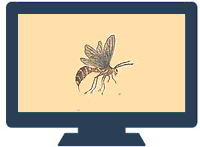Entomology, Department of
Date of this Version
2017
Document Type
Article
Abstract
Pedigo and Rice (2009) described a concept that some ecologists subscribe to called the “balance of nature” phenomenon. This idea holds that spe-cies in communities achieve certain status in their ecosystem and that this status becomes fixed and resistant to change. On average, individuals are only able to replace themselves. Fluctuations may occur, but ultimately the various species in the community will retain their position and relative population size in the ecosystem. According to these ecologists, when humans alter and reduce the diversity of an ecosystem they are acting counter to this balance. In an attempt to re-turn the altered system to its ordinary state, ex-traordinarily strong forces of nature will act in op-position to these activities. It could be argued that among these forces are biotic maladies which im-pair or destroy European honey bee (Apis mellifera) colonies. Oftentimes when honey bee diseases and pests explode and devastate apiaries, these activi-ties are merely a reaction to the “overpopulation” of the single species which humans have selected. Thus many of the problems with honey bees should come as no surprise; they function just as they would in any other scenario where a single species becomes too numerous. The only distinction is these insects are of value to humans. This is not to suggest that honey bees should be kept at “natural” rates. Honey bees provide ap-proximately $15 billion dollars in annual pollination services in the United States (U.S.) (Morse and Cal-derone, 2000). If the environment is left on its own to determine how many honey bee colonies are to exist, it could have severe humanitarian and eco-nomic consequences. Such a proposal is just as ab-surd as keeping apples, melons or tomatoes at the rate which nature sees fit. Honey bee diseases and pests are considered in ecology to be perfectly density-dependent, meaning that an increase in the density of the honey bees will result in more intense pressure from hon-ey bee pests. To attribute all of the problems in beekeeping to this single notion is a gross oversim-plification. Indeed many European honey bee pests came from other hosts such as the Asiatic honey bee (Apis cerena); therefore their deleterious effects are much more severe than would be if they had coevolved with their host. Furthermore, some of the problems with honey bee health have been attributed to abiotic factors such as inadequate nu-trition and pesticide exposure. Yet the point re-garding density-dependence is made because popu-lar sentiment often suggests that the solution to problems with honey bees is simply that more hon-ey bees are needed. The human population on Earth is expected to reach 10 billion in the 21st cen-tury (Bongaarts, 2009). As a result, there will likely need to be more honey bees added to our global agroecosystems in order to meet future food de-mands and keep food affordable. However, as new colonies are added it is imperative that disease and pest issues are kept under control, colonies are managed to maximize pollination capabilities and alternative pollinators are incorporated. Merely adding honey bee colonies without any considera-tion for the pest and disease “reaction” will only exacerbate problems in beekeeping . This guidebook is meant to assist in the promotion of honey bee health and prepare for the likely inevi-table need for an increased number of managed colonies. However it is not intended to be a diag-nostic tool or a prescription for solutions. Rather it is a summary of scientific knowledge about honey bee immunity, disease etiology, pest problems and abiotic stressors. The goal of this guide is for the reader to: 1) develop a deeper familiarity with hon-ey bee biology and the conditions that harm these insects; and 2) better understand the relative im-portance of the various problems that negatively affect colonies.


Comments
A graduate degree project submitted as partial fulfillment of the Option III requirements for the degree of Masters of Science in Entomology at the graduate school of the University of Nebraska-Lincoln, 2017.
Copyright 2017 Joey Caputo